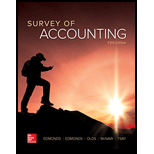
Concept explainers
Problem 7-35 Straight-line amortization of a bond discount
Pine Land Co. was formed when it acquired cash from the issue of common stock. The company then issued bonds at a premium on January 1, 2018. Interest is payable annually on December 31 of each year, beginning December 31, 2018. On January 2, 2018, Pine Land Co. purchased a piece of land and leased it for an annual rental fee. The rent is received annually on December 31, beginning December 31, 2018. At the end of the eight-year period (December 31, 2025), the land was sold at a gain, and the bonds were paid off. A summary of the transactions for each year follows.
2018
- 1. Acquired cash from the issue of common stock.
- 2. Issued eight-year bonds.
- 3. Purchased land.
- 4. Received land rental income.
- 5. Recognized interest expense including the straight-line amortization of the premium and made the cash payment for interest on December 31.
2019–2024
6. Received land rental income.
7. Recognized interest expense including the straight-line amortization of the premium and made the cash payment for interest on December 31.
2025
8. Sold land at a gain.
9. Retired bonds at face value.
Required
Identify each of these nine transactions as asset source (AS), asset use (AU), asset exchange (AE), or claims exchange (CE). Explain how each event affects assets, liabilities, equity, net income, and
Want to see the full answer?
Check out a sample textbook solution
Chapter 7 Solutions
Survey Of Accounting
- Please provide the solution to this general accounting question with accurate financial calculations.arrow_forwardMeena manufacturing company has budgeted overhead costs of $750,000 and expected machine hours of 25,000. During the period, actual overhead costs were $765,000 and actual machine hours were 24,000. Calculate the amount of over or underapplied overhead.arrow_forwardexplain properly all the answer for General accounting question Please given fastarrow_forward
 Financial Accounting: The Impact on Decision Make...AccountingISBN:9781305654174Author:Gary A. Porter, Curtis L. NortonPublisher:Cengage Learning
Financial Accounting: The Impact on Decision Make...AccountingISBN:9781305654174Author:Gary A. Porter, Curtis L. NortonPublisher:Cengage Learning Cornerstones of Financial AccountingAccountingISBN:9781337690881Author:Jay Rich, Jeff JonesPublisher:Cengage Learning
Cornerstones of Financial AccountingAccountingISBN:9781337690881Author:Jay Rich, Jeff JonesPublisher:Cengage Learning College Accounting, Chapters 1-27AccountingISBN:9781337794756Author:HEINTZ, James A.Publisher:Cengage Learning,
College Accounting, Chapters 1-27AccountingISBN:9781337794756Author:HEINTZ, James A.Publisher:Cengage Learning, Intermediate Accounting: Reporting And AnalysisAccountingISBN:9781337788281Author:James M. Wahlen, Jefferson P. Jones, Donald PagachPublisher:Cengage LearningPrinciples of Accounting Volume 1AccountingISBN:9781947172685Author:OpenStaxPublisher:OpenStax College
Intermediate Accounting: Reporting And AnalysisAccountingISBN:9781337788281Author:James M. Wahlen, Jefferson P. Jones, Donald PagachPublisher:Cengage LearningPrinciples of Accounting Volume 1AccountingISBN:9781947172685Author:OpenStaxPublisher:OpenStax College Excel Applications for Accounting PrinciplesAccountingISBN:9781111581565Author:Gaylord N. SmithPublisher:Cengage Learning
Excel Applications for Accounting PrinciplesAccountingISBN:9781111581565Author:Gaylord N. SmithPublisher:Cengage Learning





